Experimental Study of Wake Evolution under Vertical Staggered Arrangement of Wind Turbines of Different Sizes
Abstract
1. Introduction
- We propose a novel wind turbine layout approach incorporating small wind turbines into wind farm units while focusing on large wind turbines. This approach considers the mutual interactions between large and small wind turbines in a combined arrangement.
- Regarding sensor placement, an equal number of measurement points were evenly distributed at three heights: the upper blade tip, hub center, and lower blade tip. The impact of small wind turbines at various heights was analyzed from multiple perspectives, contributing to a better understanding of the vertical wake distribution within the wind farm.
- This study employed a comprehensive multi-parameter analysis for the data collected in the experiment. It considered wind speed and included factors such as turbulence integral scale and power spectral density. The study quantified the contribution of vortex motion to wake turbulence energy, providing a more detailed description of wake characteristics. This approach facilitates a comprehensive understanding of the wake evolution process.
2. Experimental Setup
2.1. Introduction of Experimental Equipment
2.2. Experimental Inlet Air Condition and Working Condition Setting
2.3. Uncertainty Analysis of Experimental Data
3. Results and Discussion
3.1. Horizontal Direction
3.1.1. Characteristics of the Spreading Wake
3.1.2. Characteristics of the Turbulent Intensity Distribution in the Wake Field
3.1.3. Turbulence Integration Scale
3.1.4. Effect of Small Wind Turbines on Wind Speed at Different Heights
3.1.5. Power Spectrum Density
3.2. Vertical Direction
3.2.1. Vertical Wake Characteristics
3.2.2. Analysis of Working Conditions
3.2.3. Turbulence Intensity
3.2.4. Vertical Power Spectrum Analysis
4. Conclusions
- (1)
- Introducing a small wind turbine downstream of the giant wind turbine significantly reduces wake velocity, with a wind speed deficit of approximately 22%. This effect varies at different heights, with the impact of the small wind turbine becoming more pronounced from the upper to lower positions of the giant wind turbine blades.
- (2)
- After work is conducted on the wind turbine rotor, the incoming wind causes structural damage to its flow. The extent of this damage is less pronounced in the far wake region, but the addition of the small wind turbine has a notable impact on the turbulence integral scale in the far wake. Under the C3 condition, the turbulence critical scale increases by 2% compared to the C0 condition.
- (3)
- In the vertical direction, the influence of the operation of the small wind turbine on the wind speed deficit increases gradually from the near wake region to the far wake region, reaching a wind speed deficit of approximately 20% at the 7D position. Simultaneously, a positive impact is observed on the outer region of the small wind turbine rotor, particularly under the C3 condition, where the wind speed at this position increases by 3%.
Author Contributions
Funding
Institutional Review Board Statement
Informed Consent Statement
Data Availability Statement
Acknowledgments
Conflicts of Interest
Nomenclature
| Symbols | |
| D | large wind turbine wheel diameter D (mm) |
| d | diameter of small wind turbine wheel d (mm) |
| h | small wind turbine hub height h (mm) |
| Iu | turbulence intensity |
| Λ | turbulent integral length |
| Vhub | hub height inflow wind speed (m/s) |
| Zhub | hub height of large wind turbines |
| τ | time interval |
| V | average flow velocity |
| u | instantaneous wind speed |
| T | turbulent integration time |
| IT | free-flow turbulence intensity |
| IT,W | turbulent intensity of wake effect |
| m | waller’s Comparison Index |
| N | number of wind turbines |
| Pw | probability conditions |
| Xi | distance from wind turbine |
| σ | standard deviation |
| C0 | All three rows of small wind turbines are not running |
| C1 | Small wind turbines in 3D position operating |
| C2 | Small wind turbines running in 3D and 5D positions |
| C3 | Small wind turbines running in 3D, 5D, and 7D positions |
References
- Available online: https://www.Nea.Gov.Cn (accessed on 29 January 2024).
- International Energy Agency. Electricity Market Report 2023; IEA: Paris, France, 2023. [Google Scholar]
- Hwangbo, H.; Johnson, A.L.; Ding, Y. Spline Model for Wake Effect Analysis: Characteristics of a Single Wake and Its Impacts on Wind Turbine Power Generation. IISE Trans. 2018, 50, 112–125. [Google Scholar] [CrossRef]
- Tang, H.; Lam, K.-M.; Shum, K.-M.; Li, Y. Wake Effect of a Horizontal Axis Wind Turbine on the Performance of a Downstream Turbine. Energies 2019, 12, 2395. [Google Scholar] [CrossRef]
- Yang, M.; Shi, C.; Liu, H. Day-Ahead Wind Power Forecasting Based on the Clustering of Equivalent Power Curves. Energy 2021, 218, 119515. [Google Scholar] [CrossRef]
- Shaler, K.; Kecskemety, K.M.; McNamara, J.J. Benchmarking of a Free Vortex Wake Model for Prediction of Wake Interactions. Renew. Energy 2019, 136, 607–620. [Google Scholar] [CrossRef]
- Gao, X.; Yang, H.; Lin, L.; Koo, P. Wind Turbine Layout Optimization Using Multi-Population Genetic Algorithm and a Case Study in Hong Kong Offshore. J. Wind Eng. Ind. Aerodyn. 2015, 139, 89–99. [Google Scholar] [CrossRef]
- Uchida, T.; Shibuya, K.; Richmond-Navarro, G.; Calderón-Muñoz, W.R. A Wind Tunnel Investigation of Yawed Wind Turbine Wake Impacts on Downwind Wind Turbine Performances and Wind Loads. Wind Eng. 2023, 47, 655–670. [Google Scholar] [CrossRef]
- He, R.; Sun, H.; Gao, X.; Yang, H. Wind Tunnel Tests for Wind Turbines: A State-of-the-Art Review. Renew. Sustain. Energy Rev. 2022, 166, 112675. [Google Scholar] [CrossRef]
- Fu, S.; Jin, Y.; Zheng, Y.; Chamorro, L.P. Wake and Power Fluctuations of a Model Wind Turbine Subjected to Pitch and Roll Oscillations. Appl. Energy 2019, 253, 113605. [Google Scholar] [CrossRef]
- Zhao, L.; Gong, Y.; Gong, F.; Zheng, B.; Wang, J.; Xue, L.; Xue, Y. Study on Mitigation of Wake Interference by Combined Control of Yaw Misalignment and Pitch. J. Mar. Sci. Eng. 2023, 11, 1288. [Google Scholar] [CrossRef]
- Heisel, M.; Hong, J.; Guala, M. The Spectral Signature of Wind Turbine Wake Meandering: A Wind Tunnel and Field-scale Study. Wind Energy 2018, 21, 715–731. [Google Scholar] [CrossRef]
- Bastankhah, M.; Porté-Agel, F. A New Miniature Wind Turbine for Wind Tunnel Experiments. Part II: Wake Structure and Flow Dynamics. Energies 2017, 10, 923. [Google Scholar] [CrossRef]
- Iungo, G.V.; Viola, F.; Camarri, S.; Porté-Agel, F.; Gallaire, F. Linear Stability Analysis of Wind Turbine Wakes Performed on Wind Tunnel Measurements. J. Fluid Mech. 2013, 737, 499–526. [Google Scholar] [CrossRef]
- Abraham, A.; Leweke, T. Experimental Investigation of Blade Tip Vortex Behavior in the Wake of Asymmetric Rotors. Exp. Fluids 2023, 64, 109. [Google Scholar] [CrossRef]
- Piqué, A.; Miller, M.A.; Hultmark, M. Laboratory Investigation of the near and Intermediate Wake of a Wind Turbine at Very High Reynolds Numbers. Exp. Fluids 2022, 63, 106. [Google Scholar] [CrossRef]
- Gao, X.; Zhang, S.; Li, L.; Xu, S.; Chen, Y.; Zhu, X.; Sun, H.; Wang, Y.; Lu, H. Quantification of 3D Spatiotemporal Inhomogeneity for Wake Characteristics with Validations from Field Measurement and Wind Tunnel Test. Energy 2022, 254, 124277. [Google Scholar] [CrossRef]
- Van Haaren, R.; Fthenakis, V. GIS-Based Wind Farm Site Selection Using Spatial Multi-Criteria Analysis (SMCA): Evaluating the Case for New York State. Renew. Sustain. Energy Rev. 2011, 15, 3332–3340. [Google Scholar] [CrossRef]
- Dou, B.; Guala, M.; Zeng, P.; Lei, L. Experimental Investigation of the Power Performance of a Minimal Wind Turbine Array in an Atmospheric Boundary Layer Wind Tunnel. Energy Convers. Manag. 2019, 196, 906–919. [Google Scholar] [CrossRef]
- Talavera, M.; Shu, F. Experimental Study of Turbulence Intensity Influence on Wind Turbine Performance and Wake Recovery in a Low-Speed Wind Tunnel. Renew. Energy 2017, 109, 363–371. [Google Scholar] [CrossRef]
- Dai, X.; Xu, D.; Zhang, M.; Stevens, R.J.A.M. A Three-Dimensional Dynamic Mode Decomposition Analysis of Wind Farm Flow Aerodynamics. Renew. Energy 2022, 191, 608–624. [Google Scholar] [CrossRef]
- Luo, K.; Yuan, R.; Dong, X.; Wang, J.; Zhang, S.; Fan, J.; Ni, M.; Cen, K. Large-Eddy Simulation and Experimental Study on the Turbulent Wake Flow Characteristics of a Two-Bladed Wind Turbine. Sci. China Technol. Sci. 2017, 60, 1861–1869. [Google Scholar] [CrossRef]
- Amin Allah, V.; Shafiei Mayam, M.H. Large Eddy Simulation of Flow around a Single and Two In-Line Horizontal-Axis Wind Turbines. Energy 2017, 121, 533–544. [Google Scholar] [CrossRef]
- Meyers, J.; Meneveau, C. Optimal Turbine Spacing in Fully Developed Wind Farm Boundary Layers. Wind Energy 2012, 15, 305–317. [Google Scholar] [CrossRef]
- Sun, H.; Yang, H.; Tao, S. Optimization of the Number, Hub Height and Layout of Offshore Wind Turbines. J. Mar. Sci. Eng. 2023, 11, 1566. [Google Scholar] [CrossRef]
- Chamorro, L.P.; Tobin, N.; Arndt, R.E.A.; Sotiropoulos, F. Variable-sized Wind Turbines Are a Possibility for Wind Farm Optimization. Wind Energy 2014, 17, 1483–1494. [Google Scholar] [CrossRef]
- Ozbay, A. An Experimental Investigation on Wind Turbine Aeromechanics and Wake Interferences among Multiple Wind Turbines. Ph.D. Thesis, Iowa State University, Ames, IA, USA, 2014. [Google Scholar]
- Sun, H.; Yang, H. Study on an Innovative Three-Dimensional Wind Turbine Wake Model. Appl. Energy 2018, 226, 483–493. [Google Scholar] [CrossRef]
- Wang, L.; Cholette, M.E.; Fu, Y.; Yuan, J.; Zhou, Y.; Tan, A.C.C. Combined Optimization of Continuous Wind Turbine Placement and Variable Hub Height. J. Wind Eng. Ind. Aerodyn. 2018, 180, 136–147. [Google Scholar] [CrossRef]
- Vasel-Be-Hagh, A.; Archer, C.L. Wind Farm Hub Height Optimization. Appl. Energy 2017, 195, 905–921. [Google Scholar] [CrossRef]
- Chen, J.; Zhang, Y.; Xu, Z.; Li, C. Flow Characteristics Analysis and Power Comparison for Two Novel Types of Vertically Staggered Wind Farms. Energy 2023, 263, 126141. [Google Scholar] [CrossRef]
- Xu, X.; Hu, S.; Shao, H.; Shi, P.; Li, R.; Li, D. A Spatio-Temporal Forecasting Model Using Optimally Weighted Graph Convolutional Network and Gated Recurrent Unit for Wind Speed of Different Sites Distributed in an Offshore Wind Farm. Energy 2023, 284, 128565. [Google Scholar] [CrossRef]
- Gajendran, M.K.; Kabir, I.F.S.A.; Vadivelu, S.; Ng, E.Y.K. Machine Learning-Based Approach to Wind Turbine Wake Prediction under Yawed Conditions. J. Mar. Sci. Eng. 2023, 11, 2111. [Google Scholar] [CrossRef]
- Xu, X.; Hu, S.; Shi, P.; Shao, H.; Li, R.; Li, Z. Natural Phase Space Reconstruction-Based Broad Learning System for Short-Term Wind Speed Prediction: Case Studies of an Offshore Wind Farm. Energy 2023, 262, 125342. [Google Scholar] [CrossRef]
- Qin, S.; Liu, D. Distribution Characteristics of Wind Speed Relative Volatility and Its Influence on Output Power. J. Mar. Sci. Eng. 2023, 11, 967. [Google Scholar] [CrossRef]
- Stiperski, I.; Calaf, M. Generalizing Monin-Obukhov Similarity Theory (1954) for Complex Atmospheric Turbulence. Phys. Rev. Lett. 2023, 130, 124001. [Google Scholar] [CrossRef]
- Yang, W.; Yu, M.; Yan, B.; Huang, G.; Yang, Q.; Zhang, S.; Hong, T.; Zhou, X.; Deng, X. Wind Tunnel Tests of Wake Characteristics for a Scaled Wind Turbine Model Based on Dynamic Similarity. Energies 2022, 15, 6165. [Google Scholar] [CrossRef]
- Malcolm, D.J.; Hansen, A.C. WindPACT Turbine Rotor Design Study: June 2000–June 2002 (Revised); National Renewable Energy Lab.: Golden, CO, USA, 2006. [Google Scholar]
- Zhao, X.; Hu, T.; Zhang, L.; Liu, Z.; Wang, S.; Tian, W.; Yang, Z.; Guo, Y. Experimental Study on the Characteristics of Wind Turbine Wake Field Considering Yaw Conditions. Energy Sci. Eng. 2021, 9, 2333–2341. [Google Scholar] [CrossRef]
- Liu, H.; Hayat, I.; Jin, Y.; Chamorro, L. On the Evolution of the Integral Time Scale within Wind Farms. Energies 2018, 11, 93. [Google Scholar] [CrossRef]
- De Zorzi, P.; Belli, M.; Barbizzi, S.; Menegon, S.; Deluisa, A. A Practical Approach to Assessment of Sampling Uncertainty. In Measurement Uncertainty in Chemical Analysis; Springer: Berlin/Heidelberg, Germany, 2003; pp. 131–137. [Google Scholar]
- Markfort, C.D.; Zhang, W.; Porté-Agel, F. Turbulent Flow and Scalar Transport through and over Aligned and Staggered Wind Farms. J. Turbul. 2012, 13, N33. [Google Scholar] [CrossRef]
- Tronaas Frandsen, S. Turbulence and Turbulence Generated Structural Loading in Wind Turbine Clusters. Ph.D. Thesis, Technical University of Denmark, Kongens Lyngby, Denmark, 2007. [Google Scholar]
- Pei, C.; Ma, C.; Wang, J.; Chen, X.; Chen, F. Influence of Turbulence Integral Length Scale on Aerostatic Coefficients of Bridge Sections. Adv. Struct. Eng. 2021, 24, 1510–1525. [Google Scholar] [CrossRef]
- Zhou, Y.; Zhou, A.; Sun, D.; Qiang, X.; Feng, S. Development of Differential Image Motion LiDAR for Profiling Optical Turbulence. Infrared Laser Eng. 2016, 45, 1130001. [Google Scholar] [CrossRef]
- He, X.; Luo, L.-S. Theory of the Lattice Boltzmann Method: From the Boltzmann Equation to the Lattice Boltzmann Equation. Phys. Rev. E 1997, 56, 6811–6817. [Google Scholar] [CrossRef]

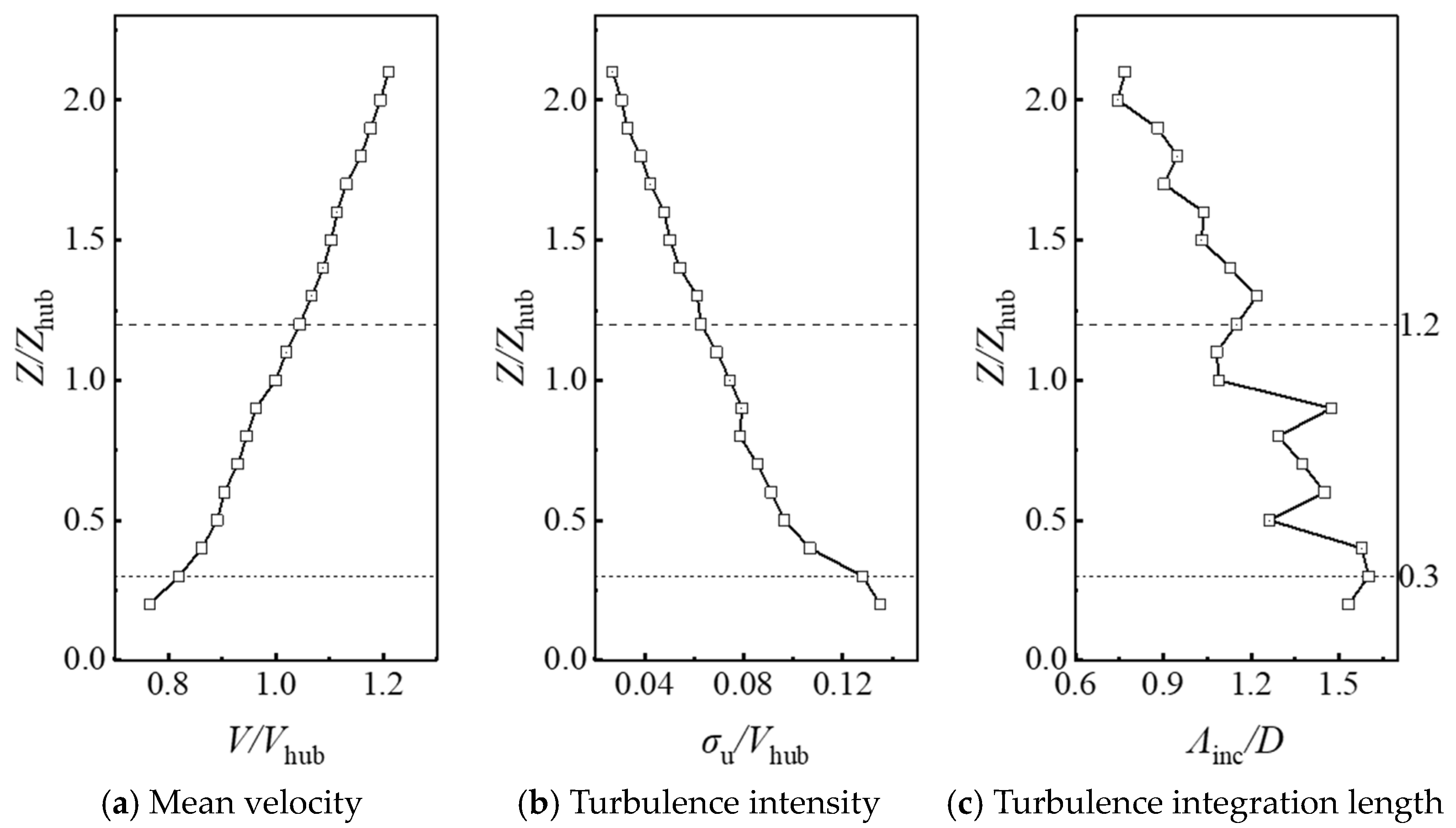

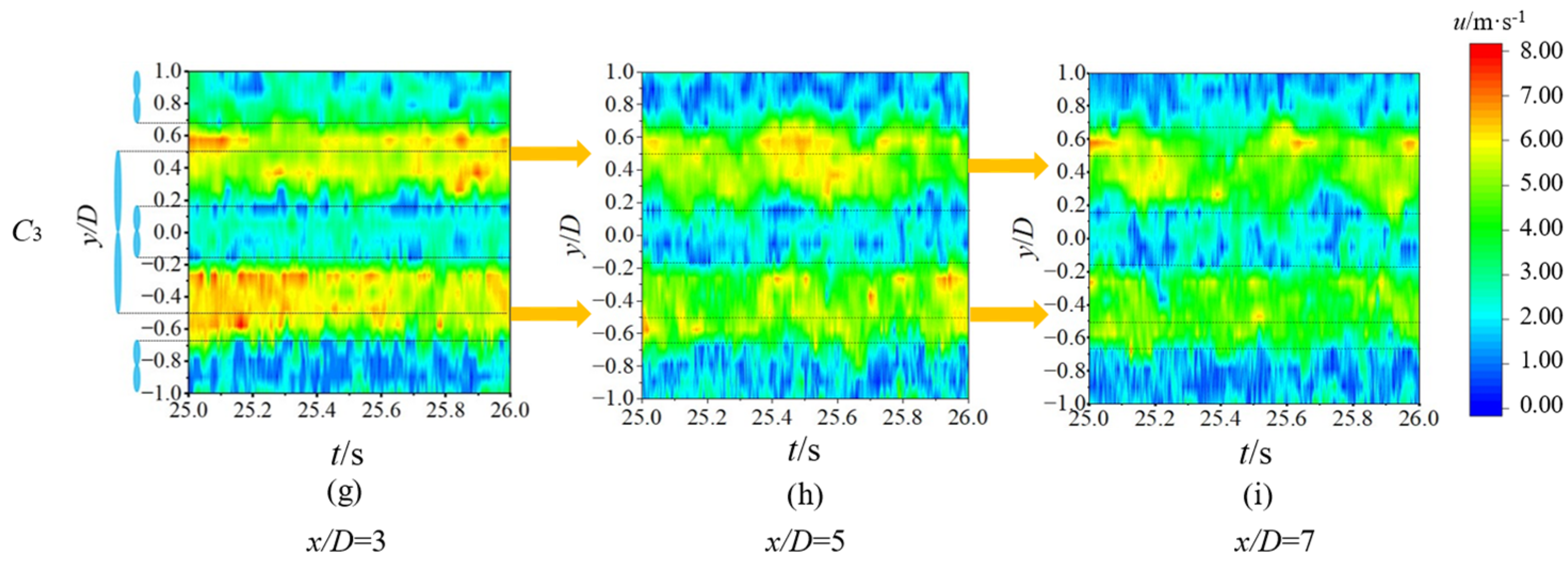
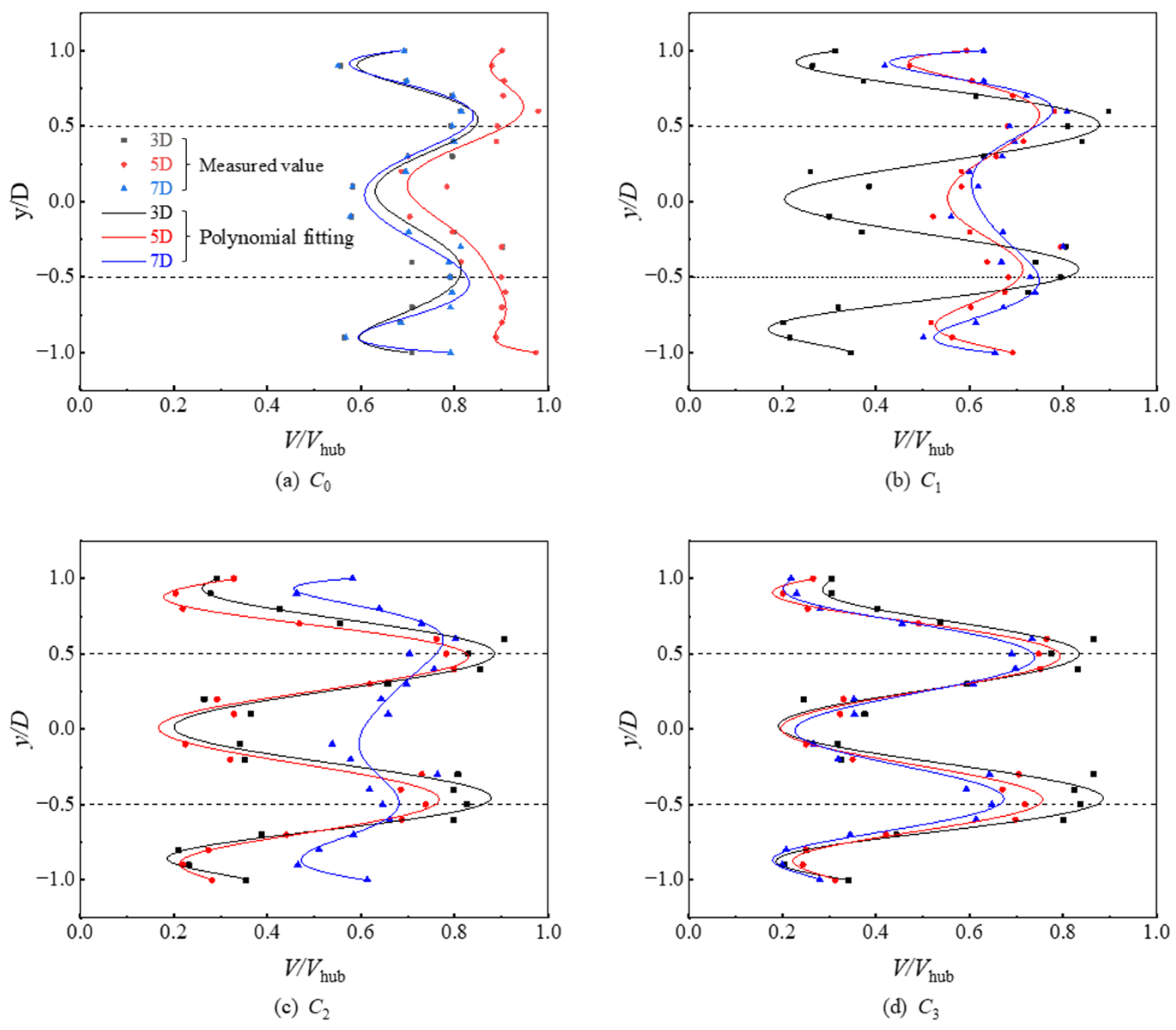


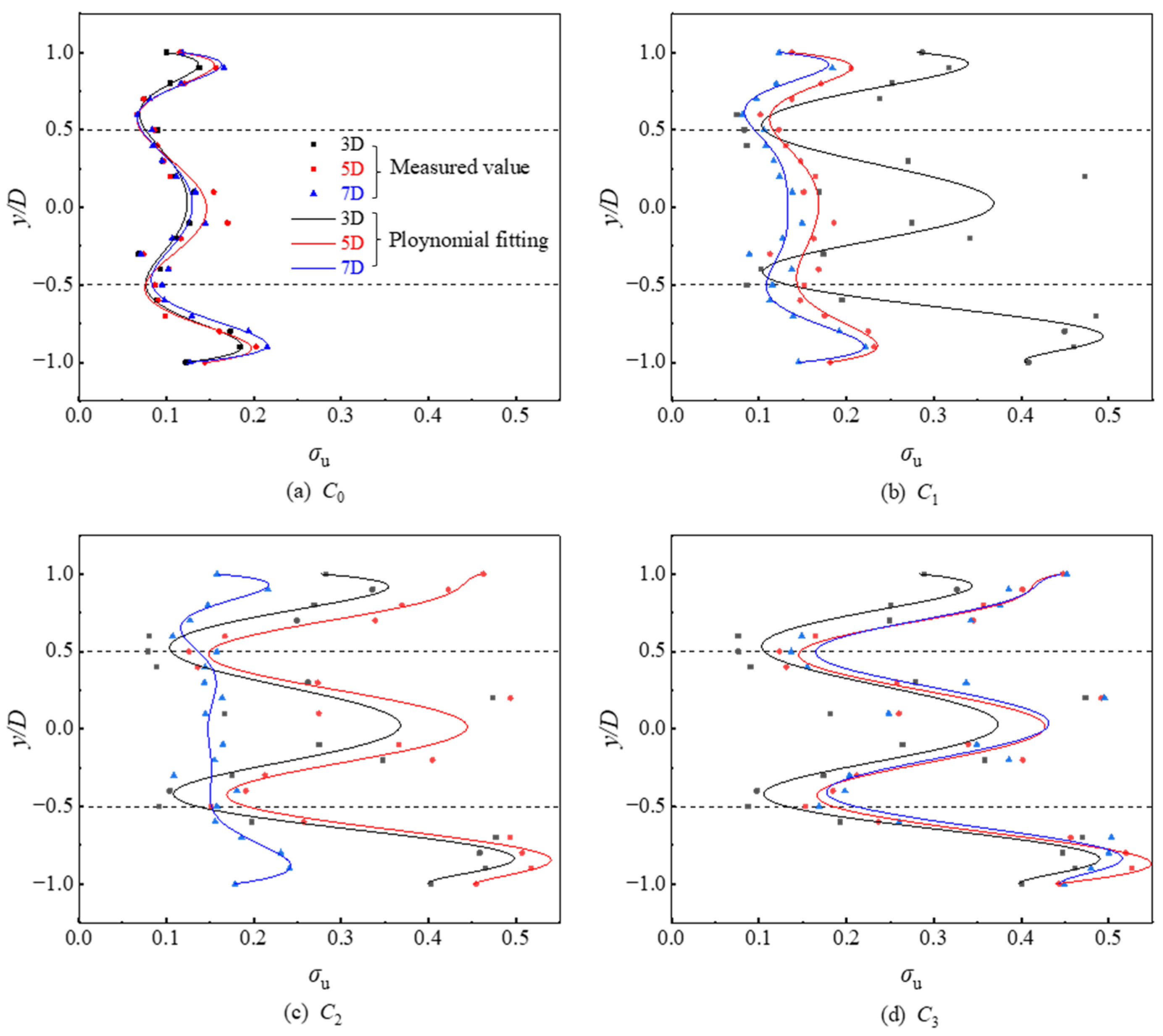
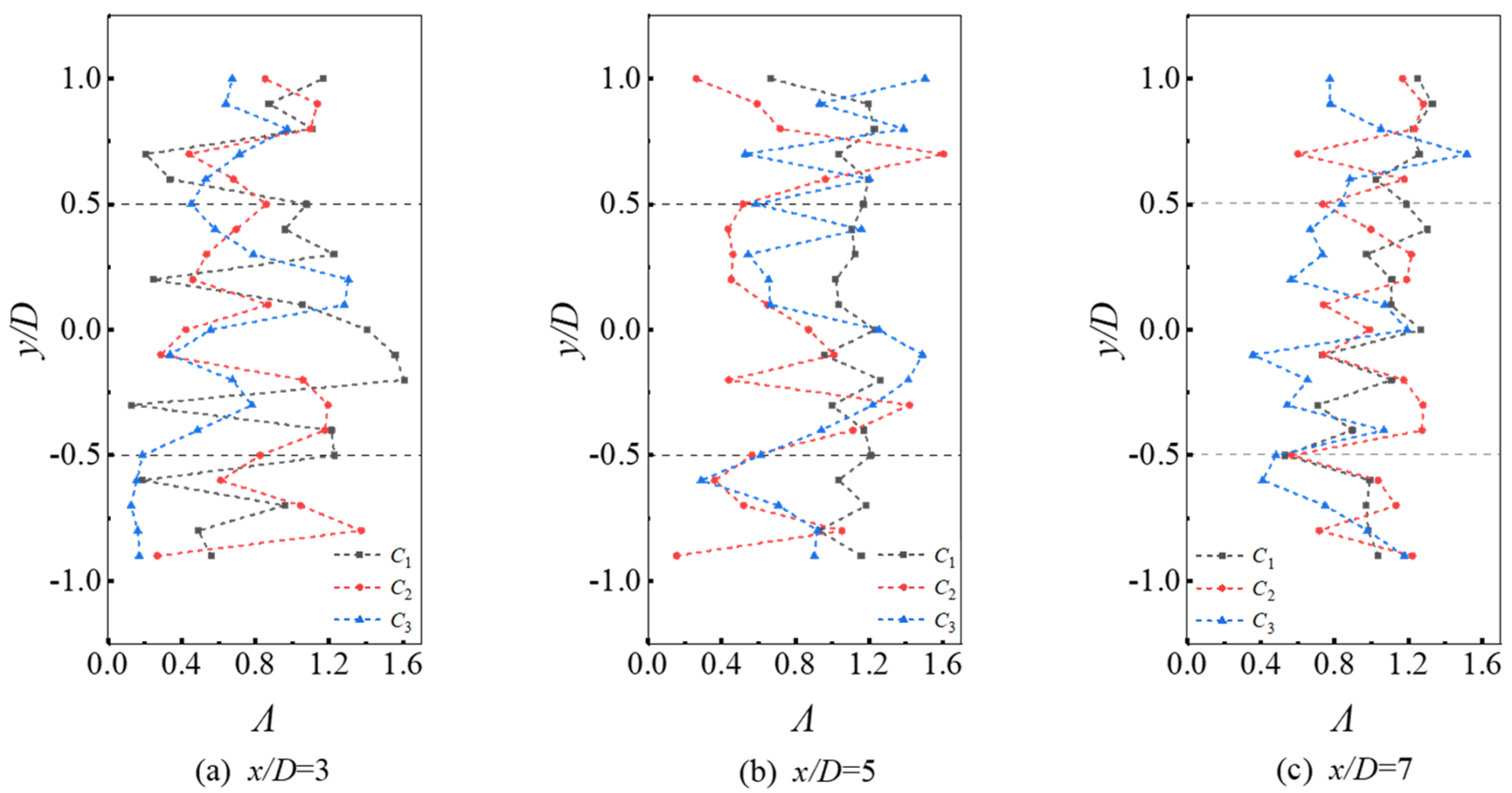

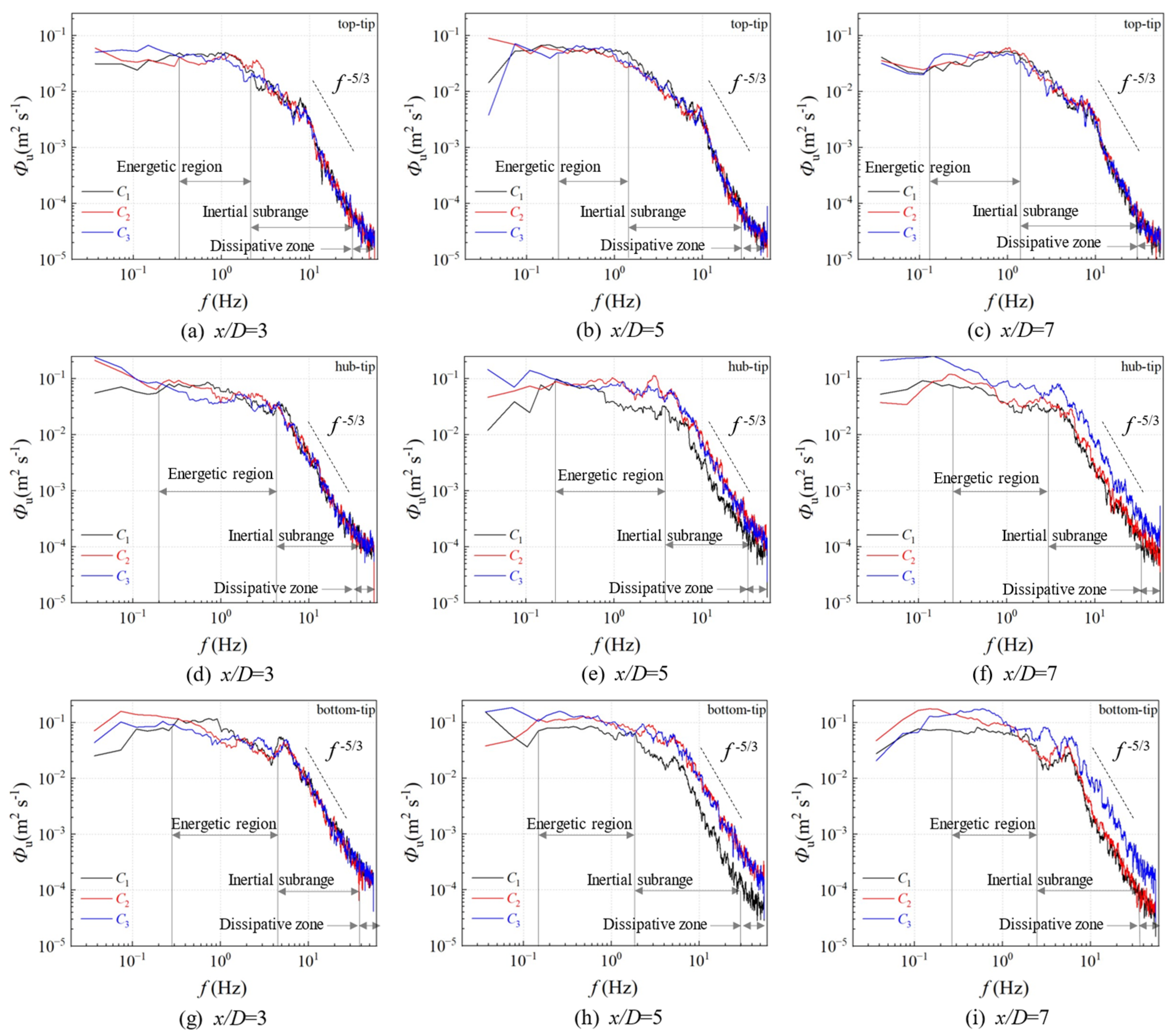
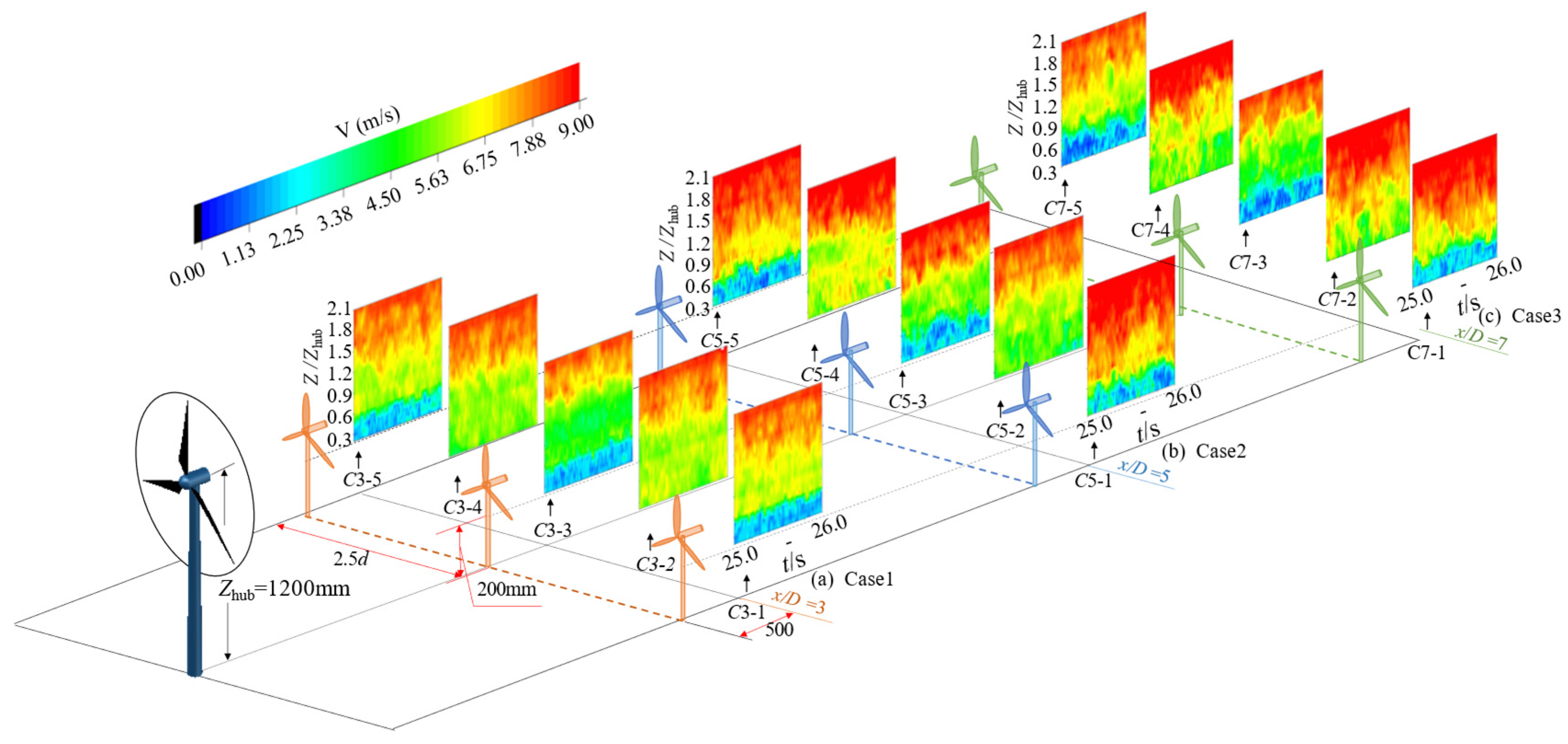
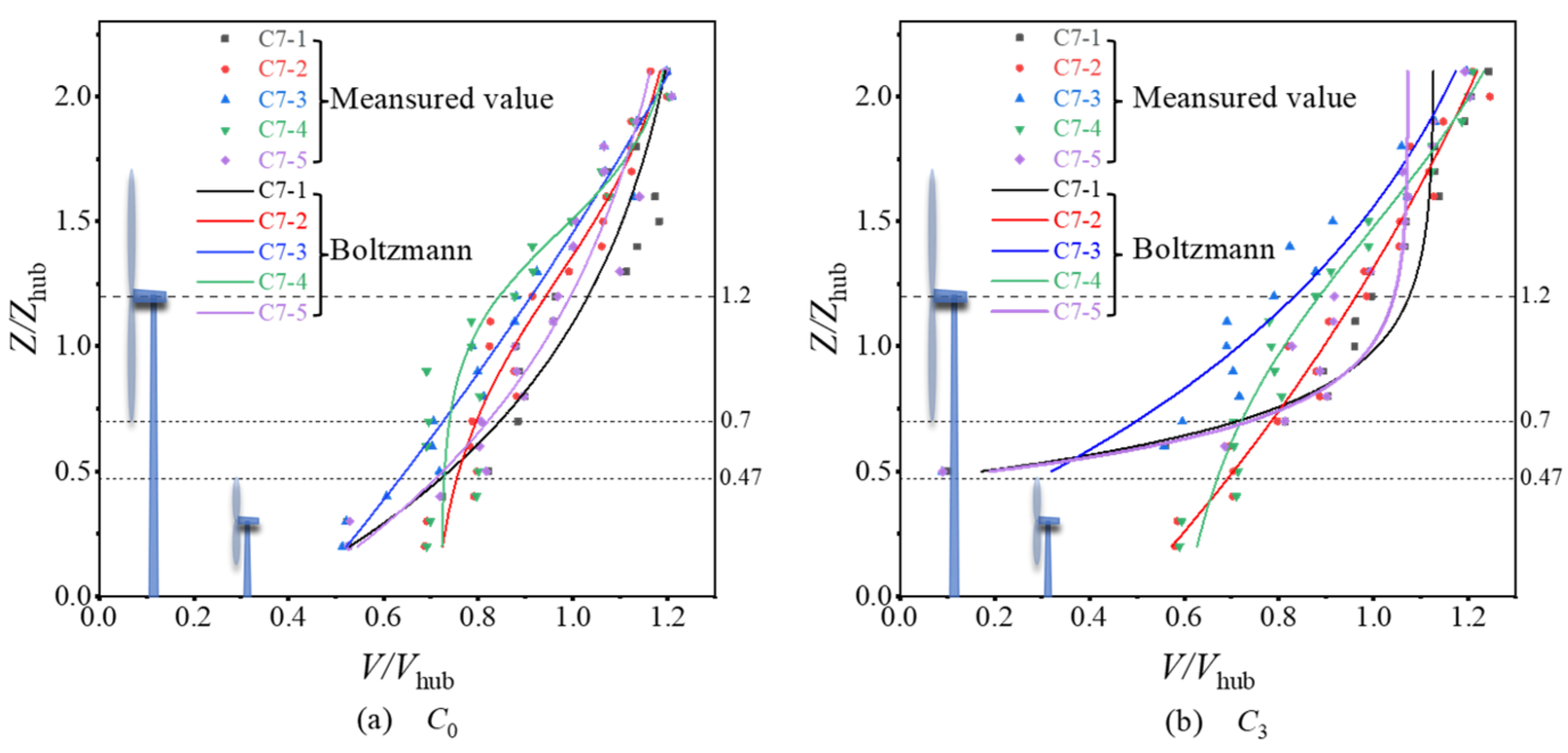

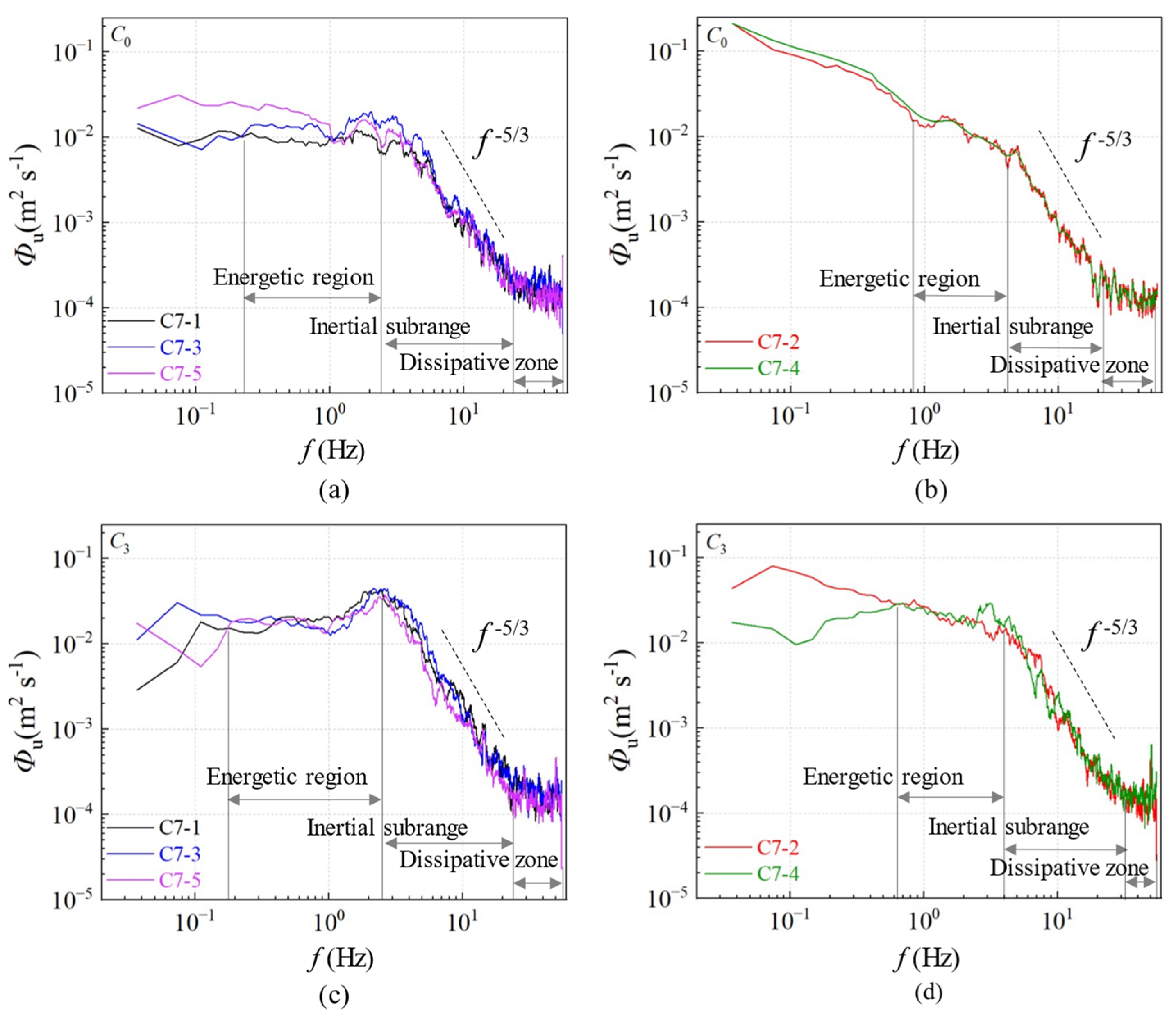
| Parameter | Value |
|---|---|
| Large wind turbine wheel diameter D (mm) | 1000 |
| Large wind turbine hub height Zhub (mm) | 1200 |
| Diameter of small wind turbine wheel d (mm) | 340 |
| Small wind turbine hub height h (mm) | 300 |
| Inlet wind speed (m/s) | 7 |
| Working Condition | Code | Small Wind Turbine Position |
|---|---|---|
| Case0 | C0 | All three rows of small wind turbines are not running |
| Case1 | C1 | Small wind turbines in 3D position operating |
| Case2 | C2 | Small wind turbines running in 3D and 5D positions |
| Case3 | C3 | Small wind turbines running in 3D, 5D and 7D position |
Disclaimer/Publisher’s Note: The statements, opinions and data contained in all publications are solely those of the individual author(s) and contributor(s) and not of MDPI and/or the editor(s). MDPI and/or the editor(s) disclaim responsibility for any injury to people or property resulting from any ideas, methods, instructions or products referred to in the content. |
© 2024 by the authors. Licensee MDPI, Basel, Switzerland. This article is an open access article distributed under the terms and conditions of the Creative Commons Attribution (CC BY) license (https://creativecommons.org/licenses/by/4.0/).
Share and Cite
Zhang, L.; Feng, Z.; Zhao, Y.; Xu, X.; Feng, J.; Ren, H.; Zhang, B.; Tian, W. Experimental Study of Wake Evolution under Vertical Staggered Arrangement of Wind Turbines of Different Sizes. J. Mar. Sci. Eng. 2024, 12, 434. https://doi.org/10.3390/jmse12030434
Zhang L, Feng Z, Zhao Y, Xu X, Feng J, Ren H, Zhang B, Tian W. Experimental Study of Wake Evolution under Vertical Staggered Arrangement of Wind Turbines of Different Sizes. Journal of Marine Science and Engineering. 2024; 12(3):434. https://doi.org/10.3390/jmse12030434
Chicago/Turabian StyleZhang, Lidong, Zhengcong Feng, Yuze Zhao, Xiandong Xu, Jiangzhe Feng, Huaihui Ren, Bo Zhang, and Wenxin Tian. 2024. "Experimental Study of Wake Evolution under Vertical Staggered Arrangement of Wind Turbines of Different Sizes" Journal of Marine Science and Engineering 12, no. 3: 434. https://doi.org/10.3390/jmse12030434
APA StyleZhang, L., Feng, Z., Zhao, Y., Xu, X., Feng, J., Ren, H., Zhang, B., & Tian, W. (2024). Experimental Study of Wake Evolution under Vertical Staggered Arrangement of Wind Turbines of Different Sizes. Journal of Marine Science and Engineering, 12(3), 434. https://doi.org/10.3390/jmse12030434







